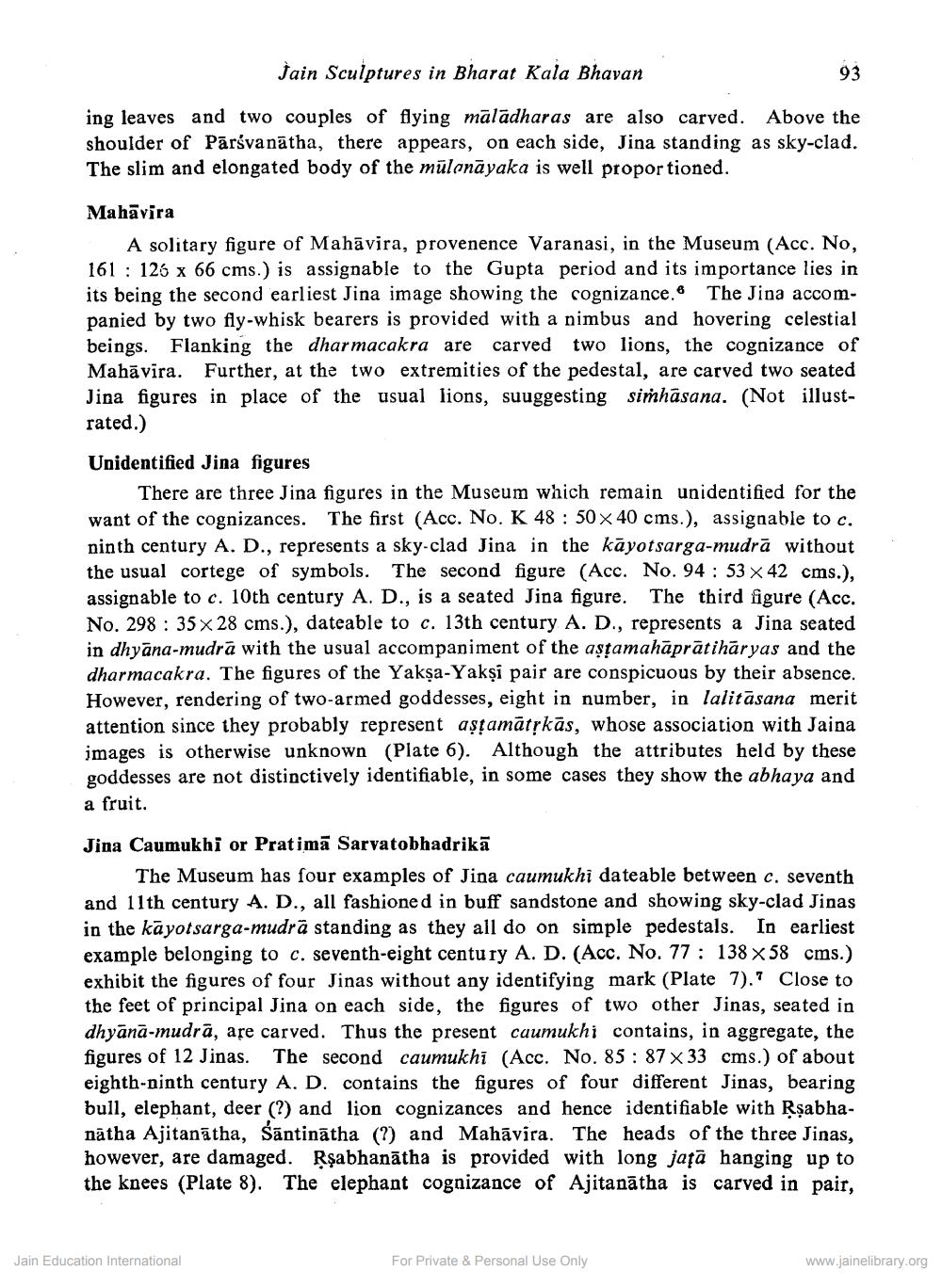Book Title: Jaina Sculptures in Bharata Kala Bhavan Author(s): Kamalgiri Publisher: Z_Aspect_of_Jainology_Part_2_Pundit_Bechardas_Doshi_012016.pdf View full book textPage 5
________________ Jain Sculptures in Bharat Kala Bhavan 93 ing leaves and two couples of flying mālādharas are also carved. Above the shoulder of Pārsvanātha, there appears, on each side, Jina standing as sky-clad. The slim and elongated body of the mülonāyaka is well proportioned. Mahāvira A solitary figure of Mahāvira, provenence Varanasi, in the Museum (Acc. No, 161 : 126 x 66 cms.) is assignable to the Gupta period and its importance lies in its being the second earliest Jina image showing the cognizance. The Jina accompanied by two fly-whisk bearers is provided with a nimbus and hovering celestial beings. Flanking the dharmacakra are carved two lions, the cognizance of Mahāvira. Further, at the two extremities of the pedestal, are carved two seated Jina figures in place of the usual lions, suuggesting simhasana. (Not illustrated.) Unidentified Jina figures There are three Jina figures in the Museum which remain unidentified for the want of the cognizances. The first (Acc. No. K 48 : 50 x 40 cms.), assignable to c. ninth century A. D., represents a sky-clad Jina in the kāyotsarga-mudrā without the usual cortege of symbols. The second figure (Acc. No. 94 : 53 x 42 cms.), assignable to c. 10th century A. D., is a seated Jina figure. The third figure (Acc. No. 298 : 35 x 28 cms.), dateable to c. 13th century A. D., represents a Jina seated in dhyāna-mudra with the usual accompaniment of the aştamahāprātiharyas and the dharmacakra. The figures of the Yakşa-Yakşi pair are conspicuous by their absence. However, rendering of two-armed goddesses, eight in number, in lalitāsana merit attention since they probably represent aştamātņkās, whose association with Jaina images is otherwise unknown (Plate 6). Although the attributes held by these goddesses are not distinctively identifiable, in some cases they show the abhaya and a fruit. Jina Caumukhi or Pratimā Sarvatobhadrikā The Museum has four examples of Jina caumukhi dateable between c. seventh and 11th century A. D., all fashioned in buff sandstone and showing sky-clad Jinas in the kāyotsarga-mudra standing as they all do on simple pedestals. In earliest example belonging to c. seventh-eight century A. D. (Acc. No. 77 : 138 x 58 cms.) exhibit the figures of four Jinas without any identifying mark (Plate 7).' Close to the feet of principal Jina on each side, the figures of two other Jinas, seated in dhyānā-mudrā, are carved. Thus the present caumukhi contains, in aggregate, the figures of 12 Jinas. The second caumukhi (Acc. No. 85: 87 x 33 cms.) of about eighth-ninth century A. D. contains the figures of four different Jinas, bearing bull, elephant, deer (?) and lion cognizances and hence identifiable with Ķşabhanātha Ajitanātha, śāntinātha (?) and Mahāvira. The heads of the three Jinas, however, are damaged. Rşabhanātha is provided with long jasa hanging up to the knees (Plate 8). The elephant cognizance of Ajitanātha is carved in pair, Jain Education International For Private & Personal Use Only www.jainelibrary.orgPage Navigation
1 ... 3 4 5 6 7 8 9 10 11 12 13 14 15
